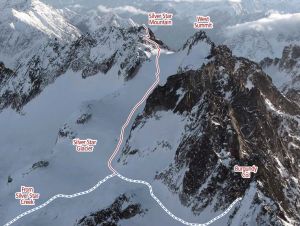Silver Star Glacier, Silver Star Mountain II 35 degree 4th class rock |
||
Washington Pass, Washington, USA | ||
| ||
|
Avg time to climb route: 1-3 hours
Approach time: 4-8 hours Descent time: 4-8 hours Number of pitches: N/A Height of route: 1,200' Overview
Silver Star Glacier is one of the finer non- technical routes in the Cascades. It is east of the crest and has far better weather than other glaciated climbs west of the crest. Silver Star is a great glacier climb earlier in the season. When many other peaks in the Cascades still have miles of snow-covered roads to contend with, Silver Star has great access as soon as Highway 20 opens. Some climbers even enjoy climbing Silver Star earlier in the season, as it doesn’t lengthen the approach but allows them to avoid all the scree hiking. The glacier has just enough going for it to keep it interesting. The final climb up to the small summit pinnacle of Silver Star is exhilarating but not hard, though some climbers might want a rope.Photos
- View all 1 photos of Silver Star Glacier as: Thumbnails | Slideshow
Climber Beta on Silver Star Glacier
Find other routes like
Silver Star Glacier
Route History
First climbed by Fred Beckey, Joe Heib, Herb Staley and Don Wilde in May of 1952. Silver Star Mountain had already been climbed either by Lage Wernsedt in 1926 or by Herman Ulrichs in 1932 via a gully from the south ending on 3rd and 4th class ledges. While climbing a new route on Silver Star from the glacier to the west was enjoyable, for Beckey, Heib, and Staley this trip was more of a reconnaissance. They were there to get a closer look at the spectacular spires to the east of the Liberty Bell group, which at this point were still labeled One through Four.This was one of Beckey’s first visits into the Wine Spire-Silver Star region. He made at least five more visits during the summers of 1952 and 1953 for the first ascents of Silver Star and three of the four Wine spires. Part of his group made the first ascent of the fourth. Strategy
Silver Star Mountain is one of a few glaciated climbs in the Washington Pass region and is semi-popular. Despite its fame, it is unusual to have to share the Silver Star Glacier with more than one other party.There are two approaches: Silver Star Creek and Burgundy Col. Silver Star Creek is best used when most of the approach is on snow. Once the Silver Star Creek valley melts out, the approach is very brushy and swampy after the good trail ends at the top of the hill around 4,850 feet Ideally, you will gain continuous snow cover within 1,000 vertical feet of the highway. Otherwise, consider taking Burgundy Col. Once past the Wine Spires, you are certainly on the glacier proper. Travel up the right (west) side of the glacier. There can be crevasses on the left (east) side of the glacier until it begins to flatten out. Once the angle eases, head diagonally toward the higher eastern summit of Silver Star. The glacier gets steeper again (30 degrees) and there can be a few more crevasses near the top of this steep section on the left side. Climb to the col dividing the east and west summits (8,600 feet). The east summit is the higher, true summit. There are many ways to go; much of this can be covered in snow in early season. Basically, ascend broken rock 300 feet to the summit. The climb starts off mostly 2nd class, before turning to 3rd class, with a final, short section of 4th class. For the final, 4th class section below the summit, some climbers may want a belay. The summit is spectacular but not big enough to spread out on and have lunch. Retreat Storm
The descent route follows the approach route.
Everything You Need to Know About
Washington Pass
Search the internet for beta on
Silver Star Glacier
|
|

